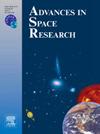空间可展开膜结构的绝对节点坐标模拟与验证
IF 2.8
3区 地球科学
Q2 ASTRONOMY & ASTROPHYSICS
引用次数: 0
摘要
可折叠膜结构具有重量轻、可折叠的特点,适合航天器大型化、轻量化的发展趋势,应用于天线、遮阳伞等部件。本文通过建立折痕动力学模型来分析空间可展开膜结构的展开。该部署模型采用折痕单元(包括预配置的ANCF壳单元)、约束模型和接触模型以及粒子群优化(PSO)参数识别方法。实验和仿真验证了模型的有效性,并对结构进行了分析。在高温和低温下的拉伸试验确定膜和折痕的动态参数。单折痕展开实验和仿真验证了模型配置的准确性。仿真结果表明了层间接触模型的必要性。多折痕展开实验和仿真验证了模型力学性能的正确性。比较高温和低温模拟,揭示低温对部署的影响。提出了一种工程可行的空间膜结构折痕建模方法。本文章由计算机程序翻译,如有差异,请以英文原文为准。
Simulation and validation of space deployable membrane structures using the absolute nodal coordinate formulation
Foldable membrane structures, with light weight and foldability, suit the trend of large-scale, lightweight spacecraft and are used in components like antennas and sunshades. This study models crease dynamics to analyze space deployable membrane structure deployment. A deployment model uses crease elements, including pre - configured ANCF shell elements, constraint and contact models, and a Particle Swarm Optimization (PSO) parameter - identification method. Experiments and simulations validate the model and analyze the structure. Tensile tests at high and low temperatures identify membrane and crease dynamic parameters. Single - crease deployment experiments and simulations verify the model’s configuration accuracy. Simulations show the necessity of the inter - layer contact model. Multi - crease deployment experiments and simulations confirm the model’s mechanical property correctness. Comparing high and low temperature simulations reveals low - temperature impacts on deployment. This paper presents an engineering feasible crease modeling method for space membrane structure design and optimization.
求助全文
通过发布文献求助,成功后即可免费获取论文全文。
去求助
来源期刊

Advances in Space Research
地学天文-地球科学综合
CiteScore
5.20
自引率
11.50%
发文量
800
审稿时长
5.8 months
期刊介绍:
The COSPAR publication Advances in Space Research (ASR) is an open journal covering all areas of space research including: space studies of the Earth''s surface, meteorology, climate, the Earth-Moon system, planets and small bodies of the solar system, upper atmospheres, ionospheres and magnetospheres of the Earth and planets including reference atmospheres, space plasmas in the solar system, astrophysics from space, materials sciences in space, fundamental physics in space, space debris, space weather, Earth observations of space phenomena, etc.
NB: Please note that manuscripts related to life sciences as related to space are no more accepted for submission to Advances in Space Research. Such manuscripts should now be submitted to the new COSPAR Journal Life Sciences in Space Research (LSSR).
All submissions are reviewed by two scientists in the field. COSPAR is an interdisciplinary scientific organization concerned with the progress of space research on an international scale. Operating under the rules of ICSU, COSPAR ignores political considerations and considers all questions solely from the scientific viewpoint.
 求助内容:
求助内容: 应助结果提醒方式:
应助结果提醒方式:


